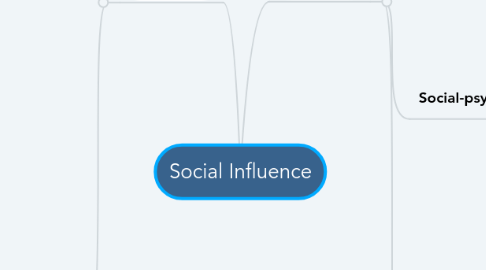
1. Conformity
1.1. Types
1.1.1. Internalisation
1.1.2. Idenitification
1.1.3. Compliance
1.2. Explanations
1.2.1. Informational SI
1.2.1.1. Lucas
1.2.1.1.1. Math probelms
1.2.1.1.2. Greater conform. to hard questions
1.2.2. Both
1.2.2.1. Deutsch and Gerald
1.2.2.1.1. Often both are involved
1.2.3. Normative SI
1.2.3.1. McGhee and Teevan
1.2.3.1.1. nAffiliators
1.2.3.1.2. Greater conform. if nAffiliator
1.3. Asch
1.3.1. Procedure
1.3.1.1. Standard/comparison lines
1.3.1.2. 123 male American undergrads
1.3.1.3. 12 of 18 trials were critical
1.3.2. Findings
1.3.2.1. 75% conformed at least once
1.3.3. Variations
1.3.3.1. Group size
1.3.3.1.1. 31.8% conformity
1.3.3.2. A dissenter
1.3.3.2.1. Less conforming
1.3.3.3. Task difficulty
1.3.3.3.1. ISI role greater
1.3.4. Evaluation
1.3.4.1. Perrin and Spencer
1.3.4.1.1. Repeated Asch's, only 1 of 396 engineering students conformed
1.3.4.1.2. Asch's is not consistent across situations and time
1.3.4.2. Fiske
1.3.4.2.1. "Asch's groups were not very groupy"
1.3.4.3. Neto
1.3.4.3.1. Women could conform more as are more concerned about social perception
1.3.4.4. Bond and Smith
1.3.4.4.1. Collectivist cultures (e.g. China where social group is more important than individual) have higher conformity
1.4. Zimbardo SPE
1.4.1. Procedure
1.4.1.1. Guards + prisoners
1.4.1.2. 16 strict rules for prisoners
1.4.2. Findings
1.4.2.1. Loss of self identity
1.4.2.2. Guards - aggressive/brutal
1.4.2.3. Prisoners - subdued/depressed/anxious
1.4.2.4. Had to stop after 6 days not 14
1.4.2.5. People easily conform
1.4.3. Evaluation
1.4.3.1. Banuazizi and Mohavedi
1.4.3.1.1. P. were acting as they assumed they were supposed to behave. One guard admitted he was copying a brutal character from the movie 'Cold Hand Luke'.
1.4.3.2. Fromm
1.4.3.2.1. Dispositional influences - only a third of the guards were aggressive. Another third applied rules fairly, rest sympathised with prisoners and tried to help them,
1.4.3.3. Ethical issues
1.4.3.3.1. Prisoners behaviour changed and they felt as though they could not ask to leave (right to withdraw).
1.4.3.4. Superintendent Zim.
1.4.3.4.1. One prisoner tried to ask to leave but Zimbardo treated the conversation as one with a real prisoner not a volunteer.
2. Obedience
2.1. Milgram
2.1.1. Procedure
2.1.1.1. 40 assorted males
2.1.1.2. Electrocuting person
2.1.1.2.1. Please continue
2.1.1.2.2. Exp. requires you continue
2.1.1.2.3. Essential you continue
2.1.1.2.4. You have no choice, continue
2.1.2. Findings
2.1.2.1. 12.5% stopped at 300v
2.1.2.2. 65% cont. to 450v
2.1.2.3. All were debriefed afterward
2.1.3. Evaluation
2.1.3.1. Orne and Holland
2.1.3.1.1. P. guessed it was not real electric shocks - lacked internal validity
2.1.3.2. Perry
2.1.3.2.1. Listened to Milgram's tapes, many P. expressed doubts about legitimacy of shocks
2.1.3.3. Sheridan and King
2.1.3.3.1. Repeated study with real shocks to a puppy. 54% of male p. and 100% of female p. used fatal voltage
2.1.3.4. Hofling
2.1.3.4.1. Nurses - 21/22 obeyed unjustified demands from superior doctors
2.2. Situational Variables
2.2.1. Proximity
2.2.1.1. Obedience dropped from 65%-40% (in room with person being electrocuted
2.2.2. Locational
2.2.2.1. Obedience to 47.5% from 65% in run down building
2.2.2.2. Miranda
2.2.2.2.1. Cross-cultural research - over 90% of Spanish students obeyed
2.2.3. Uniform
2.2.3.1. 20% if no uniform
2.2.3.2. Bickman
2.2.3.2.1. Confederates in milkman outfit/jacket and tie/security guard uniform asked passers-by for a coin for parking or to pick up litter
2.3. Social-psych Factors
2.3.1. Agentic state
2.3.1.1. Believe no responsibility as acting for an authority figure
2.3.1.2. Blass and Schmitt
2.3.1.2.1. Showed students Milgram's experiment, they said experimenter held responsibility not participants
2.3.2. Autonomous state
2.3.2.1. Believe they have free will - full moral repsonsibility
2.3.3. Binding factors
2.3.3.1. Allows P to minimise what they are doing - no harm being done/half victim's fault for volunteering
2.3.4. Legitimacy of authority
2.3.4.1. Explanation for obedience
2.3.4.2. Destructive authority - e.g. Hitler
2.3.4.3. People who are traditionally obedient obey more: Kilham and Mann - Australians 16% Mantell - Germans 85%
2.4. Dispositional Explanations
2.4.1. Authoritarian personality
2.4.1.1. A personality that means an individual is susceptible to obeying people in authority positions
2.4.2. Adorno
2.4.2.1. Procedure
2.4.2.1.1. 2000 middle-aged white Americans
2.4.2.1.2. Unconscious attitudes to racial groups
2.4.2.1.3. Potential for fascism scale (F-scale)
2.4.2.2. Findings
2.4.2.2.1. Identified with strong people and were contemptuous of the weak
2.4.2.2.2. Positive correlation between authoritarian personality and prejudice
2.4.3. Authoritarian characteristics
2.4.3.1. Obedient to authority
2.4.3.2. Show contempt to those of lower status
2.4.3.3. Conventional attitudes to race, sex and gender
2.4.3.4. Strong traditional values e.g. religion, country and family
2.4.4. Origin of authoritarian personality
2.4.4.1. Psychodynamic process
2.4.4.2. Parents - strict discipline in childhood

